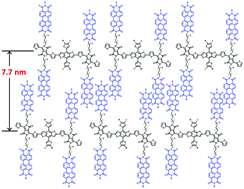Conjugated molecular dyads with diketopyrrolopyrrole-based conjugated backbones for single-component organic solar cells†
Abstract
In this work, we were able to develop a series of new conjugated molecular dyads for SCOSCs, and more importantly, we realized well-ordered nanostructures in these materials for efficient SCOSCs. The ideas started from designing three molecular dyads, in which diketopyrrolopyrrole-based conjugated backbones as donors and perylene bisimide side units as pendent acceptors were used. In addition, heteroatoms, such as sulfur and fluorine atoms, were incorporated into these molecules. We found that the sulfur-containing molecular dyads provided well-ordered lamellar structures in thin films, so they showed high photocurrent in solar cells. As a result, a power conversion efficiency (PCE) of 2.52% could be obtained, which is also among the highest PCEs of single-component conjugated molecular dyads.



 Please wait while we load your content...
Please wait while we load your content...